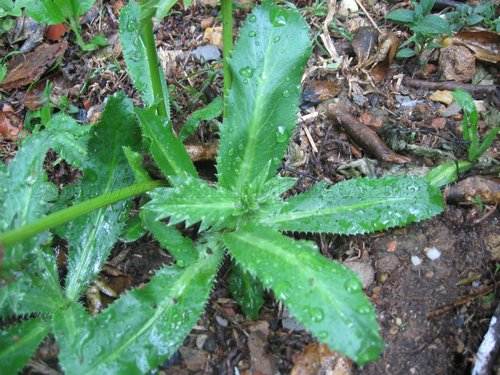What is Chadon Beni
Chadon beni or shado beni is a herb with a strong pungent scent and flavor that is used extensively in Caribbean cooking, more so Trini cooking. The scientific name for the herb is ‘Eryngium foetidum’ but in Trinidad and Tobago the popular “market” names for chadon beni are culantro or bhandhania.
Culantro is distinct from cilantro or coriander (another herb) which carries the scientific name ‘coriandrum sativum‘ and should not be confused. The confusion comes from the similarity in the two herbs’ scents. The difference between Chadon beni (or culantro) and cilantro is that chadon beni (or culantro) has a stronger and more pungent scent. It should also be noted that chadon beni belongs to the botanical family Apiaceae where parsley, dill, fennel, and celery, also belong to this botanical family. An aromatic family at that I would also add!

The leaves of the chandon beni are spearlike, serrated, and stiff spined and the dark, green, shiny leaves are generally 3-6 inches long. Each plant has a stalk, usually 16 inch tall, with smaller prickly leaves and a cone shaped greenish flower. When harvesting the herb leaves much care has to be taken because the prickly leaves of the flower can make your skin itch. But that can easily be combated by wearing gloves or gently moving aside the flower stalk while picking the the leaves.
Medicinal Properties
The leaves of the chadon beni are also rich in iron, carotene, riboflavin, and calcium, and are an excellent source of vitamin A,B, C. This herb also has medicinal properties. The leaves of the plant is a good remedy for high blood pressure, and epilepsy. In some Caribbean countries it is called fitweed because of its anti-convulsant properties. It is a stimulant and has anti-inflamatory and analgestic properties. As a matter of fact, the whole plant could be used to cure headache, diarrhea, flu, fever, vomiting, colds, malaria, constipation, and pneumonia.
The Many Names of Chadon Beni
The plant goes by a number of other names such false coriander, black benny, fitweed, duck-tongue herb, saw leaf herb, sawtooth coriander, spiny coriander, and long coriander. In Hindi it is referred to as ‘Bhandhanya’. Different countries also have its own name for this herb. Some examples are:
- Alcapate (El Salvador)
- Cilantro extranjero, cilantro habanero, parejil de tabasco (Mexico)
- Ngo gai (Vietnam)
- Pak chi farang or pak chee (Thailand)
- Racao or recao (Puerto Rico and Spain)
- Sea holly (Britain)
- Jia yuan qian (China)
- Fitweed or spiritweed (Jamaica)
- Langer koriander (Germany)
- Stinkdistel (Netherland)
- Shado beni or Chadon beni (Trinidad and Tobago)
Chadon beni grows better in hot humid climates. It can be grown from the seed, but it is slow to germinate. This plant will have to get full sun to part shade, and placed in fertile, moist, and well-drained soil.
Cooking with Chadon Beni
In Trinidad and Tobago, almost all our recipes call for chadon beni. The herb is widely used to flavor many dishes and is the base herb used when seasoning meat. It is used in marinades, sauces, bean dishes, soups, chutneys, snacks, and with vegetables.
One popular chutney we love to make on the island is “Chadon Beni Chutney” which is usually served with a favourite trini snack called pholourie (pronounced po-lor-rie). If you cannot find culantro in your market, you can always substitute it with cilantro, but you will have to increase the amount of cilantro used or search for it by its many names as listed above.
This is one of my favorite herbs in cooking and with such flavourful and health qualities, I can’t do without this simple but extraordinary herb: Chadon Beni.

great article, thank you.
You’re welcome. 🙂
Yeah thanks for the info. Having a hard time finding it at normal shops. Going to search the thai and chinese places.
great and very helpful article. can i hav the citation for this? I am doing a project involving chadon beni and would like to use some of the info in the article.
great and very helpful article. who is the author an when was it written? I would like to use some info for research purposes and believe in giving the author full credit.
My wife and I feel honoured to have this article used in your research. I did it in APA format. You will just have to put the retrieval date when you’re doing your bibliography.
Padilla, F.S.,& Hernandez-Padilla, G.(2009). Chadon beni: trini herb extraordinaire. Simply Trini Cooking Retrieved [month day year], from http://simplytrinicooking.com/chadon-beni-trini-herb-extraordinaire/
NB the title will have to be in italics
Thanks for this article. I had the pleasure of cooking at a bistro and when I pulled out my seasoning I made myself , the executive chef was mesmerized and try as I might I could not explain to him shado beni since I could not find a cross references to give him. So I will share this with them in the kitchen as they were all over the moon by the smell of the corn soup I was cooking for a community farmers market.
Rhoma
Rhoma thank you for your comment. Keep flying we Trini flag high and next time make some pholourie and chadon beni chutney for them lol!! 🙂
I live abroad and have found out I can harvest the seeds and sow. I have Chadon beni on multiple windowsills. I want to get to the point where we can cut and use when ever we want!
This herb is one of the things we miss alot!
En Costa Rica se le conoce como cilantro o cilantro coyote